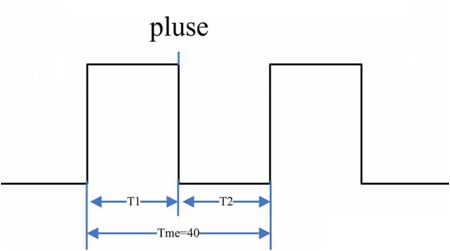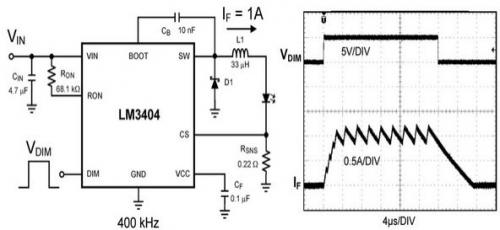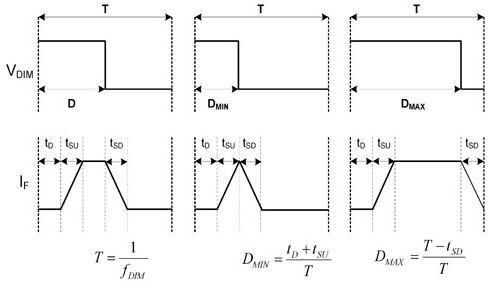Basic Knowledge of PWM Dimming
PWM, abbreviation of pulse width modulation, that is a square wave signal with a certain period and adjustable high and low levels. In a signal cycle, the high level duration is T1, and the low level duration is T1. The time is T2.
Duty cycle: in a signal cycle, the ratio of the high level duration to the signal cycle, namely T1/Time. For example, Time=40, T1=20, then the duty cycle=20/40=50%, that is, the duty cycle of the square wave signal is 50%.

When the frequency of the output pulse (reciprocal of the period) is constant, the larger the duty cycle of the output pulse, the longer its high level lasts. As long as the values of T1 and T2 are changed, the duty cycle of the waveform is changed to achieve PWM Purpose of PWM.
Either the LED is driven by a buck, boost, buck/boost or linear regulator,it is the about to control the light output among the most common thread that connects to each driver circuit. There are only few applications today that only require the simple function of ON and OFF, and most of which 0~100% slight dimming is required at present, for brightness control, there are two main solutions: to linearly adjust the LED current (analog dimming) or to switch the drive current back and forth from 0 to the target current value (digital dimming) at high frequencies that are imperceptible to the naked eye. Adopting pulse width modulation (PWM) to set the cycle and duty cycle is probably the easiest way to achieve digital dimming because the same technique can be used to control most switching converters.
PWM dimming can deploy accurate color light
Generally, analog dimming is easier to implement because the output current of the LED driver varies is set to a fixed proportional to the control voltage, and analog dimming does not arise additional electromagnetic compatibility (EMC)/electromagnetic interference (EMI) potential frequencies problems. However, the reason for PWM dimming in most designs is based on the characteristic of LEDs that the displacement of the emitted light is proportional to the magnitude of the average drive current (Figure 1). For monochromatic LEDs, the wavelength of the major light wave changes, while for white LEDs, it is the relative color temperature (CCT). Nanowavelength changes in red, green or blue LEDs are difficult to be noticed by the naked eye, especially when the intensity of the light is also changing, but changes in the color temperature of white light are easier to be detected. Most white LEDs contain a wafer that emits photons in the blue spectrum, which hit a phosphorescent coating and emit photons in various visible light ranges. At lower currents, phosphorescence will dominate and cause the light to turn yellow; at higher currents, the LED emits more blue light, causing the light to turn blue and producing a higher CCT. With more than one white LED application, the difference in CCT between two adjacent LEDs can be significant and visually unpleasant, this can be further extended for light sources that mix together the light of multiple single-color LEDs. Once there is more than one light source, any difference in CCT between them will be jarring.

Figure 2 LED driver and waveform using PWM dimming
LED manufacturers will specify the size of the drive current in their product's current characteristics table, and they will only guarantee the product's dominant wavelength or CCT under these specific current conditions. The advantage of PWM dimming is that it does not need to consider the intensity of light at all, and it can also ensure that the LED emits the color required by the designer. This precise control is especially important for red-green-blue (RGB) applications, where light of different colors is mixed to produce white light.
From the driver IC point of view, analog dimming faces serious challenges in output current accuracy. Almost all LED drivers add some form of series resistor at the output to sense the current, and the selected current sense voltage VSNS creates a coordination effect that allows the circuit to maintain a high signal-to-noise ratio (SNR), While maintaining low power consumption, errors due to tolerances, offsets and delays in the driver remain relatively constant. To reduce the output current in a closed loop system, it is necessary to reduce VSNS, but then the accuracy of the output current will decrease until the absolute value of VSNS equals the error voltage, and eventually the output current will become uncontrollable , the target output current will not be determined or guaranteed. Generally speaking, in addition to improving accuracy, PWM dimming is also stronger than analog dimming for linear control of low-level light output.
Dimming frequency is inversely proportional to contrast ratio
For PWM dimming signals, each LED has a limited response time. Figure 2 shows three different delays. The larger the delay, the lower the contrast that can be achieved (a measure of light intensity control) .

Figure 3 Dimming delay
The amount of time tD in Figure 2 represents the propagation delay from the rise of the logic signal VDIM to the start of the LED driver increasing the output current, while the amount of time tSU represents the time required for the output current to transition from 0 to the target current. As for the time The quantity tSD represents the time required for the output current to transition from the target current back to 0. In most cases, the lower the dimming frequency fDIM, the higher the contrast ratio, because these fixed delays only occupy a small part of the dimming period TDIM. The lower limit of the dimming frequency fDIM is about 120Hz, if it is lower than this frequency, the eye can no longer mix the pulses into a visible continuous light. As for the upper limit, it depends on the requirement of the minimum contrast ratio, which is generally expressed as the inverse of the minimum on-time.
CR=1/tON-MIN: 1
tON-MIN=tD+tSU
Applications such as machine vision recognition and industrial inspection often require higher PWM dimming frequencies, mainly because high-speed cameras and sensors respond much faster than the human eye. In this type of application, the purpose of switching the LED light source on and off at high speed is not to reduce the average light output, but to synchronize the light output with the capture time of the sensor or camera.
Contact:
Phone: +86-13510672827
E-mail: contact@vtecklite.com
Add: 6FL, Chuangcheng Mansion,Taiwan Industrial Estate,Shiyan Shenzhen China